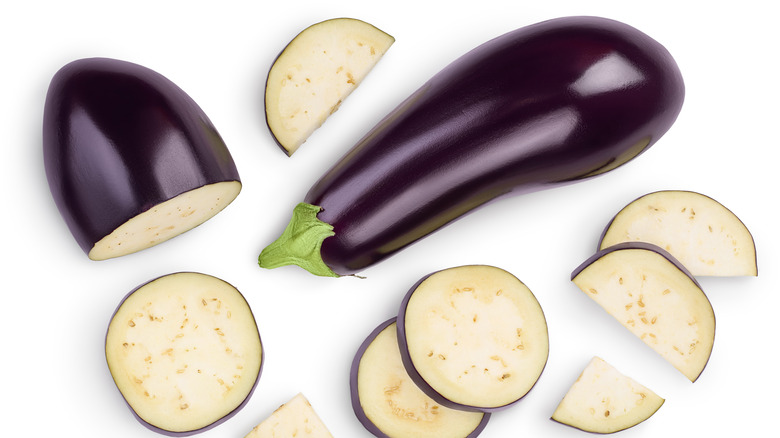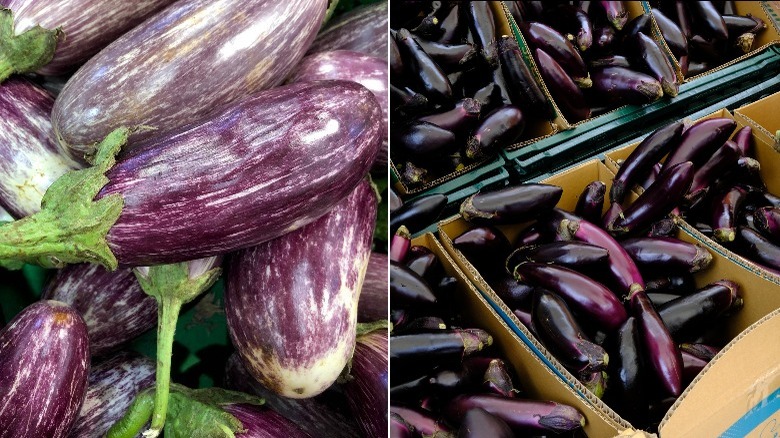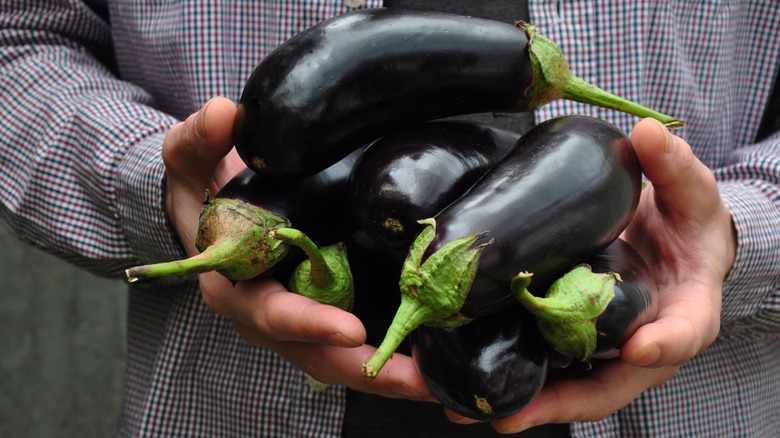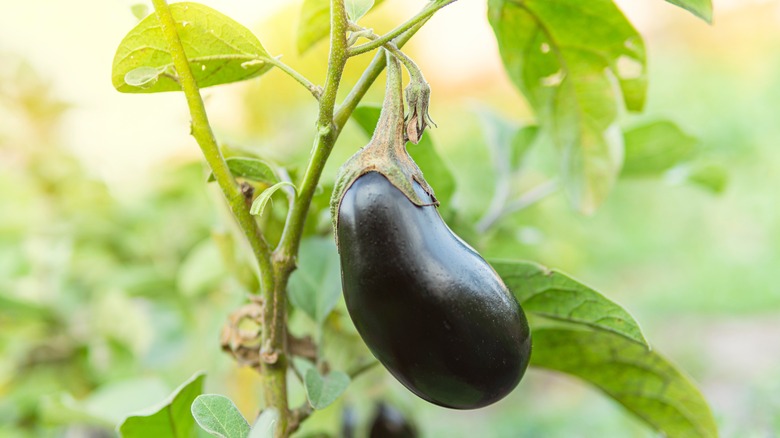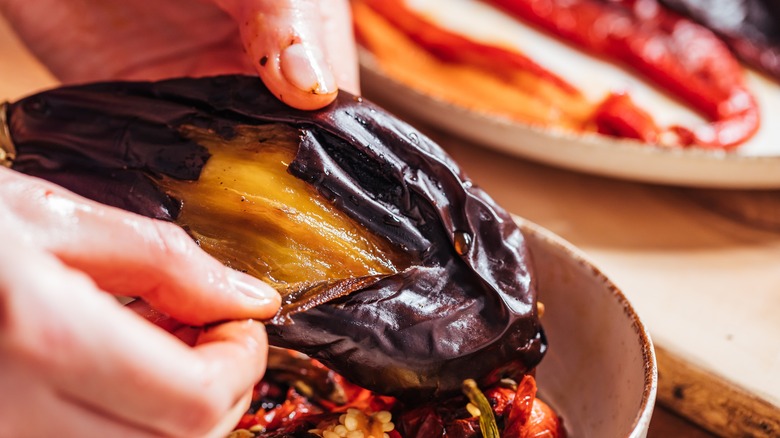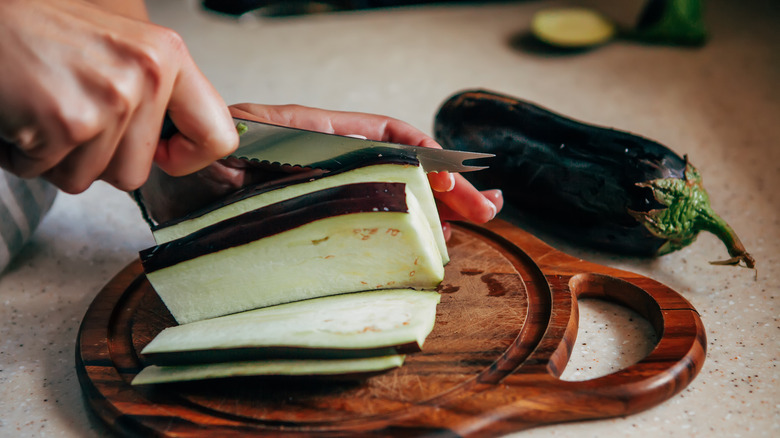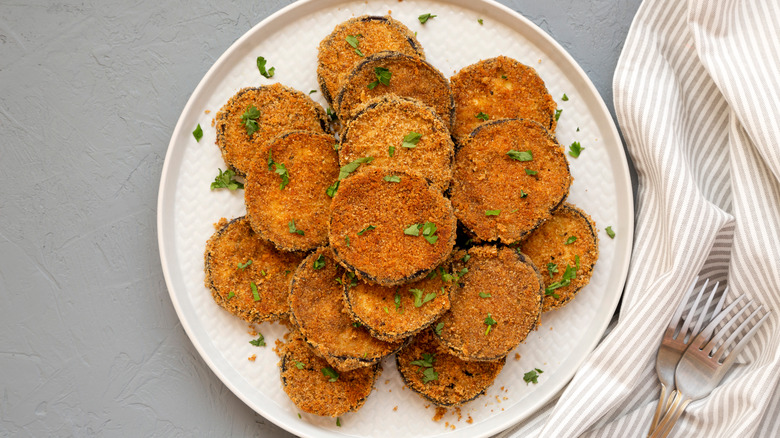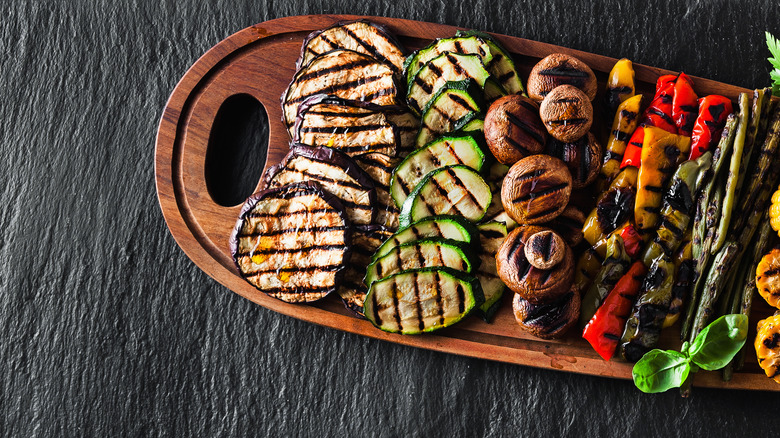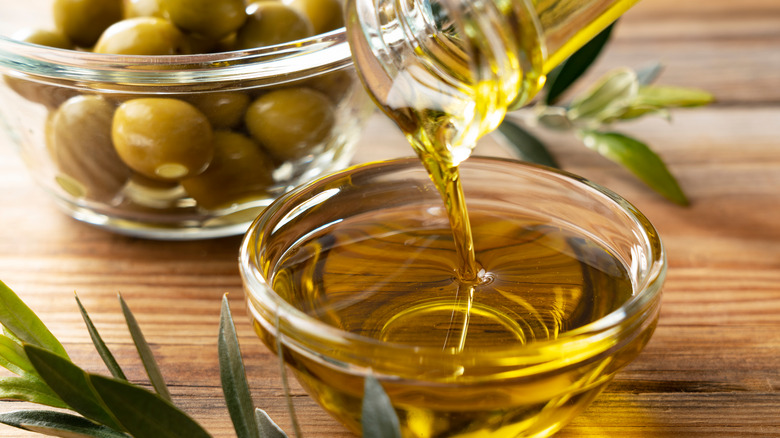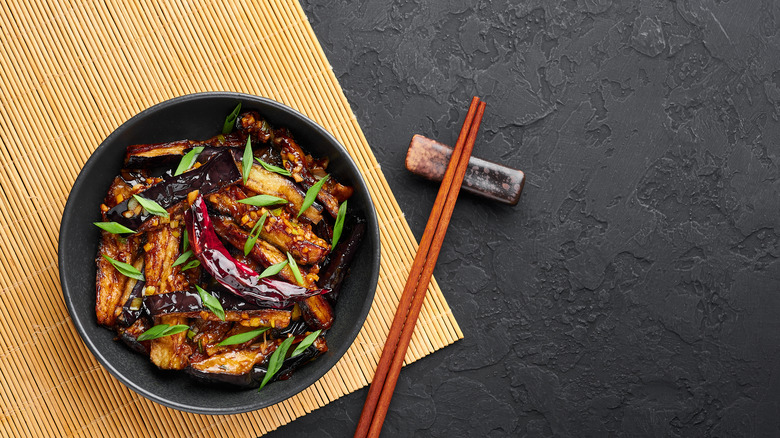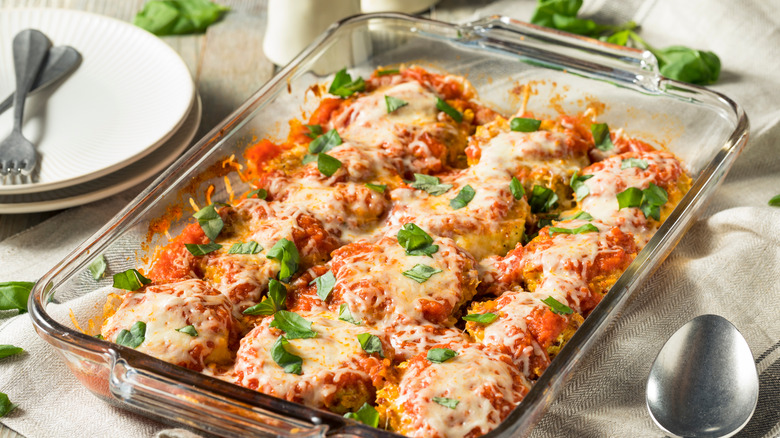Mistakes Everyone Makes When Cooking Eggplant
Eggplants are the often unloved and misunderstood member of the nightshade family. While many of us use nightshades such as tomatoes, peppers, and potatoes in our everyday lives, as WebMD points out, eggplants leave many of us scratching our heads. What are we supposed to do with these oddly shaped features of the produce section with spongy interiors.
Many people think of eggplants as bitter or, worse still, disgustingly slimy. Yet, none of this is really the poor eggplant's fault. These things are just signs of an eggplant that has not been prepared correctly. When cooked properly, this fruit — and yes, it is a fruit, according to Healthline — can be delightfully crisp and amazingly flavorful. Eggplant can be used in various side dishes, while its meaty texture makes it perfect as a meat alternative for filling entrees such as eggplant parm.
All told, eggplant is one of the great underrated foods. It is low in calories, high in fiber, and chock-full of antioxidants. But, if you have been burned before by bitter or watery eggplant, we are here to help you overcome your culinary prejudice. We want to fix eggplant's lousy reputation and show that is more than just an emoji. To help restore its good name, here's how you can avoid the mistakes everyone makes when cooking eggplant.
Not knowing the different kinds of eggplant
An eggplant is an eggplant, right? Wrong. Eggplants are not homogenous. In fact, a casual browse of a gardening catalog will show you that they come in all kinds of shapes, colors, and sizes. As it turns out, each kind of eggplant is good for a different thing. According to FreshPoint, the two most common types of eggplants available in America are the globe eggplant and the Italian eggplant. These are both large fruits with a slightly rounded shape and deep purple flesh. These are good, versatile eggplants that can stand up to most any classic eggplant dishes.
Next, there is the graffiti eggplant. These are recognizable due to their speckled white and purple skin. Graffiti eggplant also has a rounded oblong shape that many other eggplants are known for, though they work on a smaller scale. Fairy-tale eggplants are similar, only even smaller and thinner. Both are exceptionally good for grilling, so keep them in mind for your next summer cookout.
Chinese and Japanese eggplant are long and thin and come in deep purple and lavender colors. They are good for frying. As Miriam Hahn points out, they shine especially well in smaller dishes due to their size.
Storing eggplant in the wrong place
Produce storage can be tricky. For example, as per Consumer Reports, onions and potatoes should not be stored near each other, lest they cause a cycle of mutual spoilage. Some produce do well in cool, dark places, while others would rather be kept warm. While the ideal would be fresh-picked fruits and vegetables that can be used as needed, that is simply not an option for most modern folks. When it comes to storage, eggplants can be a little particular about what they like and require some planning to sit around without going off.
Eggplants have to be harvested when they are perfectly ripe, as they do not ripen well once they've been detached from the plant. That being said, they can last one to two days on the counter (via Sweetwater Organic). They should not be stored near produce that gives off high amounts of ethanol gas as this will cause them to go bad faster.
If you are in a pinch and need to save eggplant for longer than a couple of days, we recommend prepping your eggplants and freezing them rather than heading for the refrigerator. While you technically can put them in the fridge, researchers at UC Davis discovered that temperatures below 50 degrees Fahrenheit caused chilling injuries to the fruits.
Using unripe eggplant
When cooking eggplant, it's vitally important to ensure you're using a fully ripe eggplant. While you might be tempted to get an eggplant that has been harvested a little young, please don't for the sake of your cooking reputation. Eggplants do not ripen off the vine well and should be harvested at peak ripeness for best results. It may be for this reason that many eggplants in the grocery store are overripe, which can sadly lead to a tough, bitter experience when you finally bite into one.
This means that, when picking your eggplant at the store, farmer's market, or harvesting from your garden, there are a few things to look for to ensure you get a fully ripe fruit. First, as the San Diego Union-Tribune recommends, you should check the skin: is it the right color for the variety you are purchasing? For the popular globe eggplant, this means purple and shiny. Next, give it the squish test. A properly ripe eggplant will be firm, but not rock hard. If you are still unsure, cut into it. If you don't see seeds and the flesh isn't white, then your eggplant isn't ready to be cooked.
Finally, ensuring your eggplant has not gone overripe is also essential. Eggplant that has been left on the vine too long can be tough and unpleasant and can be distinguished by a matte skin that has lost its previously glossy sheen.
Peeling your eggplant
Now, to be perfectly clear, we are not saying that you should never peel your eggplant. Certainly, some recipes call for this step. However, we are simply saying that removing the peel of your eggplant by default may not be the best move. In fact, it can have a seriously negative impact on the kind of dish you are making.
The skin of the eggplant is completely edible, according to Foodiosity, and there are many reasons you might one to leave it on. For one, the skin is jam-packed with nutrients that would otherwise be lost by removing them. Mashed recipe developer Miriam Hahn always leaves the skin on for that exact reason, citing the high antioxidant levels found in an eggplant's peel. Second, as Maren Epstein points out, leaving the skin on helps the notoriously soft eggplant hold its shape in cooked dishes.
"But the skin is so tough and bitter," you may find yourself saying. Well, that means, more than likely, that you simply have an overripe eggplant. If that is the case, of course, feel free to remove the skin rather than waste the eggplant — and then keep an eye out for properly ripe eggplant on your next grocery shopping trip.
Not cutting your eggplant correctly
Cutting any produce correctly can help make a meal. According to NPR, cutting vegetables can actually affect the way they taste and the final result of a carefully crafted recipe. Thankfully, eggplants are not overly difficult to cut, and with a few helpful tips, you will be cutting eggplant like a pro for all your recipe needs.
First, you will need a knife. If you are cutting the common globe eggplant, you will need a pretty big knife to get through it, as per FreshPoint. A regular steak knife is literally not going to cut it. Instead, Misen recommends a chef knife, a santoku knife, or a serrated knife. The first offers thin sharp blades that are excellent for cutting through fresh eggplant. However, for cooked or soft eggplant, the serrated knife's "teeth" will help get through it without dismantling the delicate cooked veggie. Whatever you choose, make sure the knife is sharp.
Another tip: to get the most use out of a single eggplant, you should start by cutting off the top and bottom of the fruit. This will leave you with a nice hunk of eggplant you can cut into long slices, cubes, sticks, or rounds for the dish you are preparing.
Not salting your eggplant
It's safe to say that no one wants a soggy, and dare we say slimy, eggplant. Especially when it comes to fried eggplant recipes, having an eggplant turn out anything less than light and crisp can be seriously disappointing. Luckily there is a simple trick to help you achieve the perfectly crisp eggplant: salt it.
Sprinkling a bit of salt on your eggplant helps to pull out some its moisture. By allowing excess water to drain away, it doesn't linger in the fruit while cooking. The Los Angeles Times confirmed this when they prepared two batches of eggplant and salted one but not the other. The one they salted accumulated a rather surprising quarter inch of liquid in the bowl beneath the draining slices. What's more, those slices fried up crispier than the non-salted ones, and hit the plate with a better texture. There is also a line of reasoning that salting your eggplant will help to mask any unpleasant bitterness that might linger in the fruit.
To salt your eggplant, cut your eggplant and place it in a bowl. Generously sprinkle salt all over the cut pieces and then let them sit for an hour. Drain away the excess liquid and voila! Your eggplant will be ready for frying and ultimate, crispy perfection.
Overlapping eggplant slices when baking
Now, to be clear, this tip is really just good roasting and baking practice in general. But it makes a massive difference in the outcome of eggplant. When putting slices of fruit in the oven, be extra sure that you do not overlap the pieces.
Why? As we've written before, roasting your vegetables is what causes them to get those delicious brown caramelized bits via caramelization. This process, in which sugars in veggies (and fruits, in the case of eggplant) turn brown and grow more complex in flavor. This is what makes many types of produce tender and sweeter and gives them that beautifully crisp exterior. Unfortunately, overcrowding in your cooking dish can lead to soggy and limp vegetables, especially with water-rich eggplant.
Remember that, according to Owensboro Health, eggplants have a high water content. This means that overlapping slices of this fruit can lead to a swampy situation. To prevent this, says Applegate, avoid using a casserole dish, as baking vessel tends to trap moisture during the cooking process. If you run out of room on the baking sheet, simply use a larger sheet or just get out a second one. You may also want to work in batches.
Using the wrong amount of oil
Using the right amount of oil can be tricky when it comes to cooking eggplant. The spongy consistency of the eggplant acts as, well, a sponge, soaking up a fair amount of oil it comes in contact with (via Tefal). This is part of the reason it is so important to get rid of the excess liquid before cooking your eggplant.
If you are frying the eggplant, make sure the eggplant has been properly coated in breadcrumbs before any pieces hit the pan. You should also consider cooking them in a nonstick pan to prevent sticking without oversaturating in oil. Just be careful not to overheat that nonstick pan while you're at it. Prevention also recommends grilling eggplant. Either way, you should only need about one tablespoon of oil for frying or grilling.
Then again, you'll want to make sure you do not skimp on the oil, as that is a surefire way to turn your eggplant into a sticking mess, according to Science of Cooking. To strike the right balance, try brushing or spraying eggplant with oil right before it enters the pan so it will not have time to soak it all in.
Undercooking eggplant
Many people understandably worry about overcooking foods. But with eggplant, it is actually more important to ensure that you are not undercooking it. People often consider overcooking a sure-fire way to end up with rubbery, dry foods. It is only natural to worry about that all the more with food such as eggplant, which can be notoriously tough. So, a person would be hesitant to cook it the whole way for fear of overdoing it.
Therein lies the problem. According to Thrive Cuisine, tough eggplant can actually be a product of undercooking. Cooking the eggplant thoroughly will not just alleviate that issue, but it can also help to mellow some of the natural bitterness of the raw fruit (via The Columbian).
To check that the eggplant is fully cooked, use a fork or skewer and poke at it. If the fork goes all the way through with little resistance, then it is done. If it gets stuck or you feel some resistance, your eggplant needs more time. The truth is that, while it might seem counterintuitive, there really is no overcooking an eggplant unless you take it to extremes of time and temperature.
Using too many toppings
We hope that we have already thoroughly debunked the idea that eggplant is inherently bitter or poor tasting. On the contrary, if you are working with fresh, young eggplant, it can cook up into a lovely and mildly earthy delight. So, why on earth would you want to drown out that flavor with too many toppings?
Adding too much cheese and sauce to a dish like eggplant parmesan will do nothing less than drown the eggplant and mute your newfound eggplant cooking skills. According to Maren Epstein, you only need two tablespoons of tomato sauce to top each eggplant and mozzarella round in her recipe for eggplant Parmesan. She explains that, if you add too much sauce, the dish will simply fall apart.
For recipes that highlight eggplant without masking its natural flavor, check out this recipe for ratatouille by Erin Johnson or, for a kick of heat, this spicy Chinese eggplant recipe by Miriam Hahn, which adds flavor and heat without losing the eggplant in the shuffle.
